Repair Topics
Toilet Flapper Repair
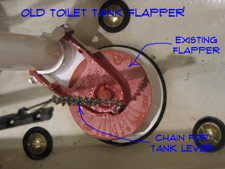 Toilet flapper repair, what could go wrong with such a simple device. A toilet that runs intermittently without being flushed will usually have a malfunctioning flapper.
Toilet flapper repair, what could go wrong with such a simple device. A toilet that runs intermittently without being flushed will usually have a malfunctioning flapper.
Not sure what your problem is? See the article on 'How To Fix a Toilet' to narrow down your problem.
At times the chain may hang up and cause the flapper not to close correctly. The rubber can age and it may not seat correctly. Adjusting or replacing the toilet tank flapper is a quick easy job.
The toilet flapper is not the only thing that can cause a toilet to run. A bad toilet flapper will cause the toilet to leak water into the tank and then run intermittently.
A toilet that runs constantly is usually caused by a bad fill valve or a float that is need of adjustment. Does it sound like the toilet fill valve? Check out this article on replacing the 'Toilet Fill Valve' and adjusting the float.
Toilet Flapper Repair - Information
What Can You Save?
You can save a service call, $50 to $100 plus the mark up for the parts. A new flapper is around five dollars.
How Hard Could It Be?
A toilet flapper repair is one of the easiest home repairs you will find.
For and explanation of the terms in this section, see 'How to Use This Site'.
Check the Simple Things!
This is a simple thing, nothing else to check. OK, there is one thing, check the chain and make sure it is not tangled.
What Can Go Wrong?
Worried about losing water. Shut the water supply off while you work on the flapper. I usually don't bother. Adjusting or replacing takes about five minutes. The water is cold, not a good idea for someone with arthritis.
Toilet Flush Valve Issues
Most of the time, replacing the toilet flapper will solve the problem. It is worth the risk to try and replace the flapper first.
Sometimes the rim of the flush valve corrupts and even a new flapper will not seal as it should. Replacing the toilet flush valve is a fairly big project. It does involve removing the toilet tank.
The toilet tank is held in place by bolts and there is a seal between the tank and the bowl. Unhooking the supply line, draining the tank, removing the flush valve, installing the new flush valve, setting the tank and getting it working again could easily take two to four hours.
Need to replace your 'Toilet Flush Valve'? Make sure you have tried fixing the flapper chain and replaced the toilet flapper before you decide to do this. See the article 'Replacing a 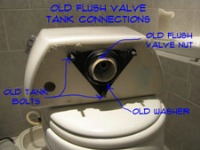 Toilet Flapper' for more information.
Toilet Flapper' for more information.
In Step One the article 'Checking the Flapper Pull Chain', helped you to make sure that the pull chain is free and working properly. This is the simplest fix of all.
'Replacing a Toilet Flapper', covered what to do when the flapper is old and worn. It may have not been seating properly, causing the water in the tank to drain down.
Replacing the toilet flapper may not have solved your problem. The article, 'Toilet Flush Valve Problems', discussed what to do if the flapper will still not seat properly.
Summary
You can't get much simpler when it comes to a repair project. A few dollars and a few minutes should be about it. I love jobs like this, when you can be a hero and not have to put out much effort.
I hope that your toilet flapper repair was not a problem. In addition, I hope that it was successful. A toilet the runs off and on and leaks constantly can be very irritating. Having solved this problem you can move onto other home repairs that you may have.
Troubleshooting Toilet Tank Repairs
To troubleshoot toilet tank repairs you need to understand that a toilet tank has a number of important components built into. To fix a toilet tank you will need to adjust or replace one of these components.
How a Toilet Tank Works
Troubleshooting Problems
Toilet runs constantly
Toilet tank refills when the toilet is not flushed.
Not enough water in the tank.
Tank does not refill.
Water trickles into the toilet bowl.
Toilet Leak Detection Tablets
 Toilet leak detection tablets are used to dye the water in the toilet tank to track down a leak. This method is used when you have a slow leak around your toilet flapper. The leak may be slow and not make any noticeable noise or disturbance in the toilet bowl.
Toilet leak detection tablets are used to dye the water in the toilet tank to track down a leak. This method is used when you have a slow leak around your toilet flapper. The leak may be slow and not make any noticeable noise or disturbance in the toilet bowl.
Toilet tank leak dye tablets can be used to find even very slight leaks. If the dye gets from the tank into the bowl, you know you have a leak.
Not sure if this is your problem? See the article 'Troubleshooting Toilet Problems' and 'Home Plumbing Repair' for more information and a listing of all the toilet related problems.
Locating Toilet Leak Detection Tablets
There are several manufacturers that make these tablets. Such as Niagara Conservation Corp, New Resources Group and AM Conservation Group. They are relatively inexpensive, although prices can vary quite a bit. Hardware stores and home supply stores may have them in stock.
To find them online, search for 'Toilet Leak Detection Tablets' or 'Toilet Tank Leak Dye Tablets'. A couple of links you can try are 'Niagara Conservation' or 'Conservation Mart'. At the time of this writing, Conservation Mart had them for $0.17 a package.
To find them locally, you may want to call ahead to your hardware or plumbing supply store to make sure they have them in stock. For such a small item, you don't want to be wasting time and gasoline driving around town.
Using Toilet Leak Dye Tablets
The toilet leak detection tablets need to go into the water inside of the tank. You use one or two tablets per the manufacturers instructions.
Remove the lid from your toilet tank. The lift straight up and should not be attached in any way. They are made of porcelain, so be careful where you set is down. Do not drop it, the toilet tank lid can crack or shatter.
Drop the tablet(s) into the water inside the tank as directed. Wait about 15 to 30 minutes for the dye tablets to dissolve or until you see the dye in the bowl. If you see dye in the bowl your toilet flapper is allowing water to drain into the toilet.
Obviously, water running down the drain for no good reason is costly. It can also be irritating since the tank will need to refill periodically. At night this can be bothersome.
Fixing Toilet Tank Leaks
For this type of leak it is one of two problems. The toilet flapper or the toilet flush valve. The toilet flapper is the easier of the two to fix. See the article 'Toilet Flapper Repair' for more information.
The other possible problem would be the toilet flush valve. The toilet flush valve is the part that the flapper is connected to. It provides the fill tube for the toilet and allows the water from the tank to enter quickly into the toilet bowl. Replacing this item is a bigger job, see 'Toilet Flush Valve Repair' for instructions.
Toilet Leaking at Base
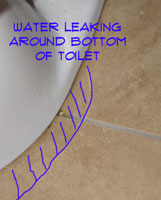 This article on 'Toilet Leaking at Base' will help you to idendity the cause of your leak and direct you to the resource that will help you fix it. This type of leak occurs when you flush the toilet. Tightening the toilet tee bolts and replacing the wax ring are two ways that this problem can be fixed.
This article on 'Toilet Leaking at Base' will help you to idendity the cause of your leak and direct you to the resource that will help you fix it. This type of leak occurs when you flush the toilet. Tightening the toilet tee bolts and replacing the wax ring are two ways that this problem can be fixed.
Before you head down this path, make sure that the leak is coming from the base. Other parts of the toilet may be leaking and creating water on the floor.
Review the troubleshooting section in the article 'Fixing a Leaking Toilet' to locate your problem. For other toilet issues you want to take a look at 'Fixing and Troubleshooting Toilets', this has a complete listing of toilet problems along with solutions.
Toilet Leaking at the Base Concerns
The first precaution would be to stop using the toilet if this is possible. The water that is leaking out of the base of the toilet is dirty water. This is water that has been in the bowl when the toilet is being used. There may be odor as well from this type of leak.
This type of leak can damage the sub floor, flooring and possibly the ceilings below the toilet. It also creates an unhealthy situation in your bathroom
You are going to want to use some disinfectant when cleaning up after this type of leak.
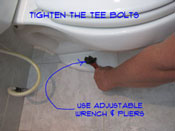 Tightening Toilet Tee Bolts
Tightening Toilet Tee Bolts
Is the toilet loose or is it bolted tightly to the floor? If it is loose, there is a good chance that the wax ring is not longer providing the proper seal.
A loose toilet can start to leak around the base. Tightening the toilet may help. There is one warning about the expectations for success with this method.
You do want your toilet fastened to the floor securely. The tee bolts that are connected to the toilet flange serve this purpose. A wax ring in compressed between the flange and the base of the toilet, forming a water tight seal. The wax ring is not elastic and will not spring back once it is compressed. With that said, tightening the tee bolts may not stop the leak if the wax ring is not sealing properly.
(1) Make sure the toilet is positioned correctly on the floor.
(2) Remove the plastic covers from the tee bolts.
(3) Use an adjustable wrench, open end or box end wrench to tighten the bolts until the toilet is secure.
(4) If the bolts are frozen or they just spin you may need to replace them. See the article 'Replacing Toilet Tee Bolts' for more information.
Replacing a Wax Ring
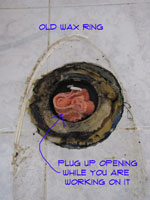 When the seal is broken between the bottom of the toilet and the wax ring, there is little you can do short of replacing it. A failed wax ring will definitely cause a toilet to leak at the base.
When the seal is broken between the bottom of the toilet and the wax ring, there is little you can do short of replacing it. A failed wax ring will definitely cause a toilet to leak at the base.
The good news is that the wax ring only costs a few dollars. The bad news is that you have to remove the toilet to replace it. This is not a five minute repair, instead it may involve a few hours and the need for some help.
(1) Purchase a suitable wax ring for your toilet. See the article 'Purchasing a Toilet Wax Ring' for more information on getting the right one.
(2) Remove the toilet from the floor and lay on its side. Caution see the article 'Removing a Toilet' before proceeding with this step. The toilet needs to be drain and shut down before removal. Additionally, you may need some help removing the toilet.
(3) Carefully clean away the old wax ring from the toilet base and the toilet flange. See the article 'Replacing a Toilet Wax Ring' for additional instructions.
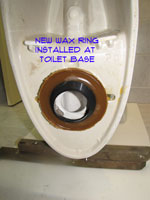 (4) Replace the toilet tee bolts if they are corroded. See the article 'Replacing Toilet Tee Bolts' for instructions on how to do a better job so they can be loosened in the future.
(4) Replace the toilet tee bolts if they are corroded. See the article 'Replacing Toilet Tee Bolts' for instructions on how to do a better job so they can be loosened in the future.
(5) Install the new wax ring on the base of the toilet. Add a filler wax ring for toilet flanges that are depressed below the floor line. See the article 'Replacing a Toilet Wax Ring' for more information.
(6) Install the toilet in its original position. You may need some help for this step. See the article 'Installing a Toilet' for additional information.
(7) Check for leaks. After the water is turn back on, check the base for leaks. You may want to wait a few days before you caulk the base to make sure that your problem is solved.
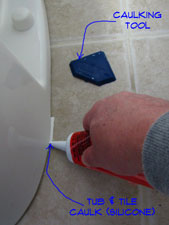 Caulking the Base of a Toilet
Caulking the Base of a Toilet
Caulking around the base of the toilet is not a solution for a toilet that is leaking around the bottom. The reason for caulking around the base is to keep water from mopping and other sources from getting under the base of the toilet.
Water that is trapped under the base may cause mold and odors that cannot be reached. The caulking will keep the water out on the floor where it can be cleaned up.
The leaking toilet bottom should be repaired before caulking is installed. Once you have made the repairs, you can review the article 'Caulking a Toilet Base' for some information on properly sealing the bottom of the toilet.
Toilet Leaking at the Base – Summary
Have you been able to fix the leak at your toilets base? Still have issues? Return to 'How To Fix a Leaking Toilet' for more topics. You can also return to the 'Home Repair Central - Home Page' for additional information.
Toilet Supply Line Leaking
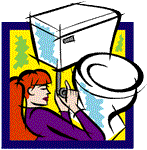
There are four possible places that a toilet supply line can leak. Sometimes it is difficult to tell where the water is coming from. It is possible for water to be leaking from the tank and running down the supply line, making it appear that the supply line or valve is the problem.
Not sure if this is your problem? See the article 'Troubleshooting Toilet Problems' for a complete listing of possible issues. For general plumbing questions, see 'Plumbing Repair for Homeowners'.
Since leaks can be deceptive and water runs down hill, we will work from the top down in locating the leak.
Be Careful
Older toilets may have corroded brass lines and corroded fittings. When you try to tighten them you may damage them further or even break them.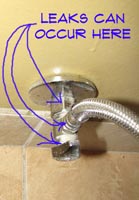
Locating Toilet Supply Line Leaks
We will work from the toilet back to the wall to locate the problem. Use a dry rag and your finger to determine which spot is leaking. (1) At the nut that connects the supply line to the Fill Valve. (2) The nut that connects the supply line to the shut off valve. (3) The connection where the valve attaches to the water line. (4) The washer in the valve itself.
Fill Valve Inlet Nut
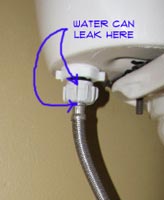 Use a pair of adjustable pliers or an adjustable wrench to tighten the nut that attaches to the Fill Valve. Do not over tighten. Make sure the nut is not cross threaded before you start to tighten. You should be able to make several turns by hand without difficulty. Some older nuts may have a loose washer that may have gone bad. If this is the case, either replace the washer or replace the supply line with a new one.
Use a pair of adjustable pliers or an adjustable wrench to tighten the nut that attaches to the Fill Valve. Do not over tighten. Make sure the nut is not cross threaded before you start to tighten. You should be able to make several turns by hand without difficulty. Some older nuts may have a loose washer that may have gone bad. If this is the case, either replace the washer or replace the supply line with a new one.
Supply Line Valve Nut
The nut that attaches the supply tube to the valve can also be tightened. Use both a pair of pliers and an adjustable wrench when you do this. Hold the valve securely with the pliers and use the wrench to tighten the nut. Take it easy until the leak stops. If the leak won't stop, you may have to replace the supply line. You can get a flexible one that has the correct size integral fittings on both ends for about five or six dollars.
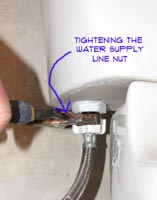
Valve Connection at Water Line
There are two types of connections at the water line. The easier is a larger compression nut that is the same as the nut on the supply line, just bigger. Before you try working on a water supply valve it is a good idea to turn off the water. Especially if the valve is old.
Tighten this nut in the same way you would the smaller one. Use the pliers to hold the valve and the wrench to tighten the nut. Tighten it until the leak stops. Turn the water back on to check for leaks as needed. Take your time and be careful.
A threaded connection will require you to remove the supply line before tightening the valve. You will need to hold the nut on the water line with a wr
ench and use another wrench or large pliers to turn the valve. You can try tightening it one full turn or a portion of a turn. Turn the water back on to check for leaks. If the leak stops, re-attach the supply line, if not, try to tighten some more.
Shut Off Valve
The shut off valve has a washer inside of the housing that keeps it from leaking. A large nut under the handle holds the assembly in place. If the water is coming out around the stem then try tightening this nut. Hold the valve with the pliers and use a wrench to tighten.
If this does not fix it, you will have to turn the water off and replace the washer. Obtain the right sized washer and replace. You can also replace the entire valve. Get a quarter turn ball cock valve if you do. They have far fewer problems.
Toilet Supply Line Leaking – Summary
Toilet supply lines generally leak at one of the connections, either at the toilet tank or at the valve. Often, you can solve the problem by tightening the fitting.


